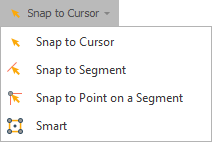Snap Options

These commands are also accessible via the Quick Access Toolbar. See: Design Panel Commands
The Snap tools are an important element in drawing Haulage Network Layers and Shapes.
Snaps are drawing aids which are used in conjunction with other Drawing Tools to help you draw accurately. That's because on a 2D computer monitor the Snap Option determines how to interpret your mouse-click in 3D space.
|
|
Snap to Cursor (the default) uses your current camera view and a fixed Z value (or grade after first click as an option) to snap to the tip of the cursor and determine the coordinates of the point under the mouse. The other three options relate to using the position of objects on the screen like Solids and Triangulations. |
|
|
Snap to Segment: Snaps to a point along a segment of a shape |
|
|
Snap to Point on Segment: Snaps to the nearest end point on a segment of a shape. |
|
|
Smart: A hybrid of the Snap to Segment and Snap to Point on Segment modes. |
Z value
Enter a fixed Z value that will be used by the Snap to Cursor tool.
If you're already familiar with the concept of snapping, the most important application relates to how to draw Network (Attach and Detach) Rules.
As you start to draw Haulage Network Shapes it may be your instinct to use Snap to Segment to create intersections or to otherwise connect to an existing shape. However, the only way to guarantee that Haulage Network Shapes will connect is to use Snap to Point on a Segment.
Common Usages of Snap:
-
Snap to Cursor: Fixed Z or Fixed Grade Shapes
-
Snap to Segment: Tracing Shapes along Triangulation surfaces
-
Snap to Point on a Segment: Connecting Haulage Network Shapes together
Tip: Press , (comma) or . (period) to cycle through the available Snap options.
Limits
When Snap to cursor or Smart Snap mode is selected, you have the option to set the Limits of the Snap operation (None is the default).